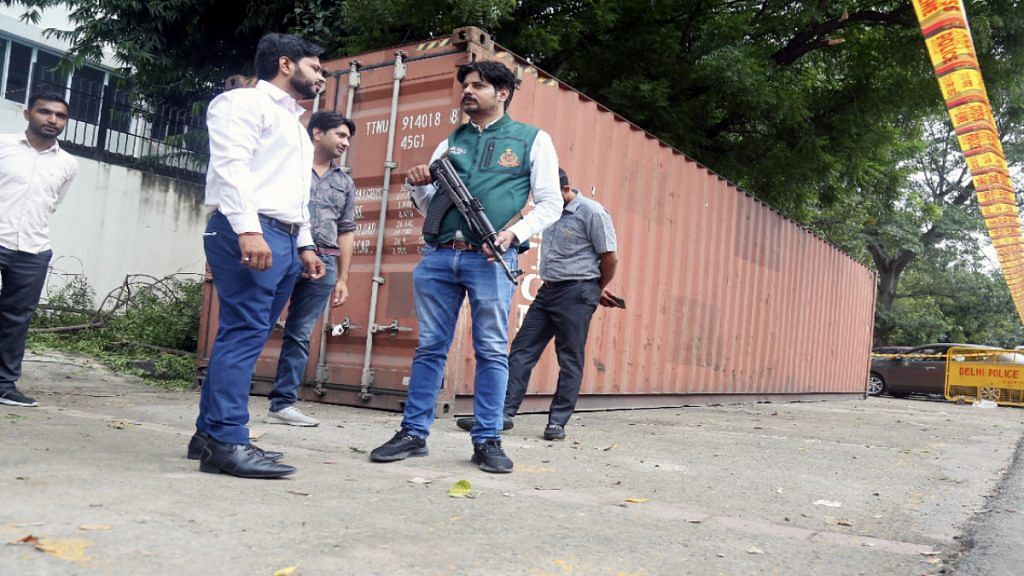New Delhi: In an innovative way of concealing drugs, over 20,000 kg of licorice (mulethi) roots that were soaked in liquid heroin worth Rs 1,725 crore and then sundried for transportation, were seized by the Delhi Police Special Cell from Jawaharlal Nehru Port Trust (JNPT), also known as Nhava Sheva Port, in Navi Mumbai.
The colour of the drug-soaked mulethi is what gave it away, a source in Delhi Police, who was part of the operation, told ThePrint. While the unadulterated sticks had a natural brown wooden shade, the ones that were soaked with heroin were darker and that is what led to its identification, he said.
The plan was to transport the roots to a factory and then extract the heroin from it through a reverse chemical process, he added.
According to the source, the information about such a consignment — 350 to 400 gm of heroin soaked per kg of licorice roots, was received during the interrogation of two Afghan nationals Mustafa Stanikzai and Rahimullah Rahimi, who were arrested under the Unlawful Activities (Prevention) Act earlier this month. Drugs worth worth Rs 1,200 crore — 312.5 kg methamphetamine and 10 kg heroin — were seized from them.
Acting on the information, a team of the Special Cell reached the Mumbai port on 16 September. The search continued till the next day.
Special Commissioner of Police, Special Cell, H. S. Dhaliwal said that this is “one of the biggest seizures of heroin”. “In the efforts to break the entire syndicate, the accused were put to sustained interrogation based on the available technical and human intelligence and the material collected during the investigation. The continuous efforts further lead to an information about the consignment of licorice roots at JNPT and the team was sent to Mumbai,” he said.
The same team of officers, led by ACPs Lalit Mohan Negi and Hridaya Bhushan, under the supervision of Deputy Commissioner of Police P. S. Kushwaha, had seized 300 kg of heroin in 2019, and 58 kg and 354 kg of heroin in two operations in 2021, Dhaliwal said.
Also Read: Gujarat ATS intercepts Pakistani boat on Arabian Sea, seize drugs worth Rs 200 cr
‘Each stick was checked’
According to Dhaliwal, when the officers reached the spot, it was found that during a preliminary examination by the authorities, the entire consignment had already been checked and the bags in which the consignment was kept was damaged.
The licorice roots were lying loose inside the container, Dhaliwal said, adding that is when the officers started checking each and every single root.
“This set of officers, while investigating previous cases involving large contraband consignments, had developed a temperament for thoroughly examining such large consignments having drugs in concealed form. The team inspected the container from all possible perspectives including the cavity, if any, on the body. Finally, the team started to inspect each and every stick of the consignment which was weighing around 20,000 kg in total,” he said.
While checking, it was observed that some sticks looked different from the others.
“It was observed that the colour of some of the sticks of licorice root was darker than the others. During the night-long tedious exercise, and continuous hard work, the team was finally able to detect heroin in all the sticks that were darker in colour,” he said.
Also Read: Central Bureau of Narcotics destroys 1,032 hectares of illicit cannabis cultivation in HP
Middle-East to Mumbai
According to police sources, the said consignment, which originated from a neighbouring country, was first shipped to a Middle-Eastern country to avoid detection by the agencies and from there, it was shipped to JNPT, Mumbai.
Had it gone undetected, the consignment from Mumbai would have been transported to makeshift factories based in Madhya Pradesh, Punjab, Delhi, Haryana and other states for extraction and processing to get heroin, the earlier mentioned source explained.
The source also said that ever since the team has started to pursue narcotic modules, various methods of concealment of heroin have surfaced. At times, it is concealed in liquid heroin-soaked bags, as well as hidden in different legitimate exports like silica gel, talc stone, gypsum powder, basil seeds and in packaging material like gunny bags and cartons.
“This makes the task difficult for the law enforcement agencies to detect and recover contraband being pushed into India in huge quantities,” he said, adding that this module of international drug syndicate is suspected to be part of a “bigger network involving terror links, for which further investigation is underway”.
(Edited by Theres Sudeep)
Also Read: UP: 3 arrested for trafficking drugs through social media
